Students must start practicing the questions from CBSE Sample Papers for Class 10 Science with Solutions Set 5 are designed as per the revised syllabus.
CBSE Sample Papers for Class 10 Science Set 5 with Solutions
Time: 3 Hours
Maximum Marks: 80
Instructions
- This question paper consists of 39 questions in 5 sections.
- All questions are compulsory. However, an internal choice is provided in some questions. A student is expected to attempt only one of these questions.
- Section A consists of 20 objective-type questions carrying 1 mark each.
- Section B consists of 6 Very Short questions carrying 2 marks each. Answers to these questions should be in the range of 30 to 50 words.
- Section C consists of 7 Short Answer type questions carrying 3 marks each. Answers to these questions should be in the range of 50 to 80 words.
- Section D consists of 3 Long Answer type questions carrying 5 marks each. Answers to these questions should be in the range of 80 to 120 words.
- Section E consists of 3 source-based/case-based assessment units of 4 marks each with sub-parts.
Section A
Select and write the most appropriate option out of the four options given for each of the questions 1-20.
Question 1.
Consider the following figure,
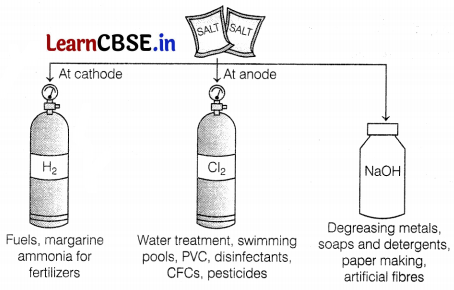
Which of the following two products are obtained from the process shown in the given figure?
(i) HCl
(ii) Bleach
(iii) Litmus
(iv) H
2
SO
4
(a) (i) and (ii)
(b) (i) and (iii)
(c) (i) and (iv)
(d) (ii) and (iv)
Answer:
(a) (i) and (ii)
Hydrochloric acid and bleach are important products that are obtained from the chlor-alkali process.
Question 2.
Which of the following is not observed in a homologous series? Give a reason for your choice.
(A) Change in chemical properties.
(B) Difference in -CH
2
, and 14u molecular mass.
(C) Gradation in physical properties.
(D) Same functional group.
Answer:
(A) Change in chemical properties.
Explanation: Change in chemical properties is not observed in a homologous series. The chemical properties of all compounds in a series remain the same.
Question 3.
Which of the following gives the correct increasing order of acid strength?
(a) Water < acetic acid < hydrochloric acid
(b) Water < hydrochloric acid < acetic acid
(c) Acetic acid < water < hydrochloric acid
(d) Hydrochloric acid < water < acetic acid
Answer:
(a) Water < acetic acid < hydrochloric acid
Hydrochloric acid is a mineral acid and ionizes completely in water, that’s why it is a strong acid. Acetic acid is an organic acid and ionizes only partially in the water, hence, it is a weak acid. Water is neutral. Thus, the order of acidity is water < acetic acid < hydrochloric acid.
![]()
Question 4.
Metal oxides generally react with acids, but few oxides of metal also react with bases. Such metallic oxides are:
(i) MgO
(ii) ZnO
(iii) Al
2
O
3
(iv) CaO
(A) (i) and (ii)
(B) (ii) and (iii)
(C) (iii) and (iv)
(D) (i) and (iv)
Answer:
(B) (ii) and (iii)
Explanation: Some metal oxides, such as aluminum oxide, zinc oxide, etc., show both addict as well as basic behavior. Such metal oxides can react with both adds as well as bases to produce salts and water. Metal oxides of this category are known as amphoteric oxides.
Question 5.
Which of the following is not the use of graphite?
(a) It is used as a lubricant
(b) It is used in the manufacturing of lead-pencils
(c) It is used in the manufacturing of artificial diamond
(d) It is used for making insulated plates
Answer:
(d) It is used for making insulated plates
Graphite can not be used for making insulated plates, as it is a good conductor of electricity.
Question 6.
When you add a few drops of acetic acid to a test-tube containing sodium bicarbonate powder, which one of the following is your observation?
(A) No reaction takes place.
(B) Acolourless gas with a pungent smell is released with brisk effervescence.
(C) A brown-colored gas is released with brisk effervescence.
(D) Formation of bubbles of a colorless and odorless gas.
Answer:
(D) Formation of bubbles of a colorless and odorless gas.
Explanation: When a few drops of acetic add are added toa test-tube containing sodium bicarbonate powder, it leads to the formation of sodium acetate along with the release of carbon dioxide gas, which is a colourless and odorless gas.
Question 7.
The structural formula of benzene is
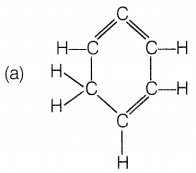
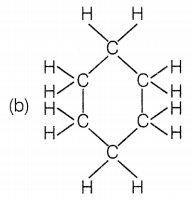
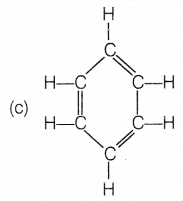
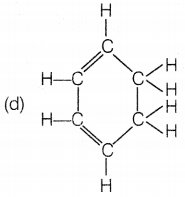
Answer:

Benzene molecules contain alternate single and double bonds. Its formula is C
6
H
6
. In structure (a), double bonds are not at alternate positions. In structure (b), the formula is C
6
H
12
and in structure (d), the formula is C
6
H
8
.
Question 8.
The number of chromosomes in parents and offsprings of a particular species undergoing sexual reproduction remains constant due to:
(A) doubling of chromosomes after zygote formation.
(B) halving of chromosomes after zygote formation.
(C) doubling of chromosomes before gamete formation.
(D) halving of chromosomes at the time of gamete formation.
Answer:
(D) halving of chromosomes at the time of gamete formation.
Explanation: The number of chromosomes in parents and offspring of a particular species undergoing sexual reproduction remains constant due to the halving of chromosomes through the process of meiosis at the time of gamete formation.
Question 9.
Identify the option that indicates the correct substrate for the enzyme that is secreted in the mouth, stomach, and small intestine respectively.
(a) Proteins, Proteins, Lipids
(b) Starch, Proteins, Lipids
(c) Starch, Lipids, Starch
(d) Starch, Lipids, Proteins
Answer:
(b) Starch, Proteins, Lipids
The mouth secretes salivary amylase which breaks down starch into sugars. Stomach secretes pepsin enzyme which breaks down proteins into smaller peptides and amino acids. In the small intestine, bile juice emulsifies fats while lipase breaks them.
Question 10.
Given below are two columns, Column I shows enzymes secreted by the glands in the alimentary canal of human beings and Column II indicates the components of food on which enzymes act. Choose the options showing correct matching.
| Column I(Enzymes) | Column II(Component) |
| (a) Pepsin | Starch |
| (b) Trypsin | Proteins |
| (c) Lipase | Proteins |
| (d) Amylase | Emulsified fat |
Answer:
(B) is correct
Explanation: Trypsin breaks down proteins into smaller peptides in the duodenum of the small intestine. Pepsin is a stomach enzyme that serves to digest proteins found in ingested food. Lipase is an enzyme the body uses to break down fats in food so they can be absorbed in the intestines. Amylase helps your body break down starches.
![]()
Question 11.
Select the correct option regarding the movement shown by Mimosa Pudica.
(a) The movement is non-directional and occurs due to turgor changes.
(b) The movement is an immediate response to a stimulus.
(c) The movement is in response to touch and is called xyctinasty.
(d) The movement is non-directional and involves growth.
Answer:
(a) The movement is non-directional and occurs due to turgor changes.
The leaves of Mimosa pudica respond to stimuli such as touch, blow or mechanical shack by folding their leaflets and lowering their leaves. This effect is caused by a change in the turgidity of the leaflets brought about by the movement of water into and out of the parenchymatous cells of the swollen leaf base.
Question 12.
During pollination, plants ensure that the pollen grain from a species germinates on the stigma of the same species. Which of the following ensures this?
(A) Hydrotropism
(B) Chemotropism
(C) Phototropism
(D) Geotropism
Answer:
(B) Chemotropism
Explanation: Chemotropism in plants leads to the growth of pollen tubes towards the ovules and thus helps in the fertilization process.
Question 13.
Which of the following phenomena of light are involved in the formation of a rainbow?
(a) Reflection, refraction and dispersion
(b) Refraction, dispersion, and total internal reflection
(c) Refraction, dispersion, and internal reflection
(d) Dispersion, scattering, and total internal reflection
Answer:
(c) Refraction, dispersion and internal reflection
A rainbow is caused by dispersion, refraction, and internal reflection of sunlight by tiny water droplets, present in the atmosphere and always formed in a direction opposite to that of the sun. The water droplets act like small prisms. They refract and disperse the incident sunlight, then reflect it internally, and finally refract it again when it comes out of the raindrop.
Question 14.
When we enter a dark room coming from outside, immediately, the things inside the room do not appear clear to our eyes. This is because:
(A) pupils do not open at all in the dark.
(B) pupils take time to adjust.
(C) light travels slower in a dark room.
(D) pupils open very quickly in the dark.
Answer:
(B) pupils take time to adjust.
Explanation: When we enter a dark room coming from outside, immediately, the things inside the room do not appear clear to our eyes. This is because pupils take time to adjust.
Question 15.
The development of a seedling from an embryo under appropriate conditions is called
(a) regeneration
(b) germination
(c) vegetative propagation
(d) pollination
Answer:
(b) germination
Germination is a process occurring in plants in which the embryo develops into a seedling under appropriate conditions.
Question 16.
Excessive exposure of humans to UV rays results in
(i) damage to immune system.
(ii) damage to lungs.
(iii) skin cancer.
(iv) peptic ulcers.
(A) (i) and (ii)
(B) (ii) and (iv)
(C) (i) and (iii)
(D) (iii) and (iv)
Answer:
(C) (i) and (iii)
Explanation: Excessive exposure of humans to ultraviolet (UV)-rays results in:
(i) Skin cancer.
(ii) Damage to the immune system of the body.
Directions (Q.Nos. 17-20) consist of two statements – Assertion (A) and Reason (R). Answer these questions by selecting the appropriate option given below.
(a) Both A and R are true and R is the correct explanation of A.
(b) Both A and R are true but R is not the correct explanation of A.
(c) A is true, but R is false.
(d) A is false, but R is true.
Question 17.
Assertion (A): Carbon shows maximum catenation property in the periodic table.
Reason (R): Carbon has a small size and thus, forms a strong C—C bond.
Answer:
(a) Both A and R are true and R is the correct explanation of A.
Catenation is the bonding of atoms of the same element into a series called a chain. Catenation occurs more readily with carbon, which forms strong covalent bonds with other C-atoms to form long chains and structures.
![]()
Question 18.
Assertion (A): Amoeba takes in food using finger like extensions of the cell surface.
Reason (R): In all unicellular organisms, the food is taken in by the entire cell surface.
Answer:
(C) A is true but R is false.
Explanation: Amoeba takes in food using temporary finger-like extensions of the cell surface, called pseudopodia, which extend and fuse over the food particle forming a food vacuole. Inside the food vacuole, complex substances are broken down into simpler ones which then diffuse into the cytoplasm. A unicellular organism does not need a specific organ for taking in food, because the entire surface of the organism is in contact with the environment.
Question 19.
Assertion (A): Amoeba an omnivore organisms.
Reason (R): A lion is a carnivore organism.
Answer:
(b) Both A and R are true, but R is not the correct explanation of A.
Amoeba is an omnivore organism, It feeds upon both plant and animal matter. Its mode of nutrition is holozoic. Lion is a carnivore organism because it eats other animals (meat eaters).
Question 20.
Assertion (A): Greater number of individuals is present in lower trophic levels.
Reason (R): The flow of energy is unidirectional.
Answer:
(B) Both A and R are true, and R is not the correct explanation of A.
Explanation: There are generally a greater number of individuals at the lower trophic levels of an ecosystem; the greatest number is of the producers. The flow of energy in an ecosystem is always linear or unidirectional. The energy captured from producers does not revert solar input. Also, the energy that passes to the herbivores does not come back to autotrophs.
Section B
Questions No. 21 to 26 are Very Short Answer Questions.
Question 21.
A metal taken does not react with cold as well as hot water, but it reacts with steam. Identify the metal and write the chemical equations involved.
Answer:
Aluminium only reacts with steam but does not react with hot or cold water. The chemical equations involved are as follows: (2)

Question 22.
In the experimental set up on CO
2
is released during respiration’, if one forgets to keep the vial with KOH in the conical flask, how will the result vary? Give details.
Answer:
In the absence of KOH, CO
2
released by germinating seeds is not absorbed, a partial vacuum is not created in the conical flask, air pressure in the flask is not reduced, and the water level does not rise in the delivery tube.
Detailed Answer:
The rise in the level of water indicates that CO
2
is produced by germinating seeds during respiration. The germinating seeds respire and produce C02, which is absorbed by KOH solution. This creates a vacuum in the conical flask. The air present in the bent glass tube moves into the conical flask. This pulls the water in the bent tube further up.
So, if one forgets to keep the vial with KOH solution in a conical flask during an experiment, then the released CO
2
will not be absorbed due to which the level of water will not rise in the tube and the process of respiration will get very slow.
Question 23.
List the components and functions of transport systems in highly organized plants.
Or
Explain, why the transportation of materials is necessary for animals.
Answer:
The main components of the transport system in highly organized plants are the xylem and phloem. These can be explained as
- The xylem consists of tracheids and vessels. It conducts water and minerals (obtained from the soil) to the leaves. (1)
- Phloem consists of sieve tubes and companion cells. It helps to transport food materials, etc. from leaves to various parts of the plant. (1)
Or
The distribution of all essential substances such as food, oxygen, and water throughout the body is carried out through the system of transportation. It also displaces excretory wastes collected from the cells of the body to the excretory organs from where they are expelled from the body. Thus, transportation of materials is necessary to carry out various life processes. (2)
Question 24.
A lens made of material with refractive index 1.5 is immersed in a liquid with refractive index 1.5. The diagram shows two rays incident on the lens when it is immersed in the liquid.
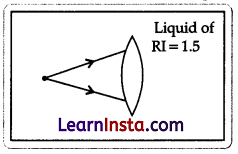
Copy the diagram and draw the light rays after they pass through the lens. Justify your diagram.
Answer:
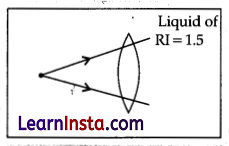
Since the refractive index of the liquid is equal to that of the material of the lens, the light rays do not undergo refraction as they pass from the liquid to the lens and back into the liquid.
Question 25.
A convex lens forms a real and inverted image of a needle at a distance of 50 cm from it. Where is the needle placed in front of a convex lens, if the image is equal to the size of the object? Also, find the power of the lens.
Or
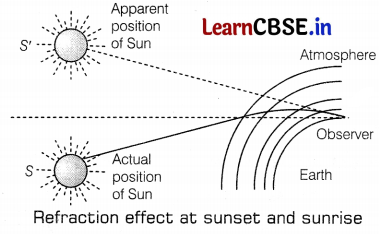
From the figure given above, explain the phenomena of advanced sunrise and delayed sunset.
Answer:
Given, image distance, v = +50 cm
Magnification, m = -1 [∵ image is inverted]
m = \(\frac{v}{u}\)
⇒ u = \(\frac{v}{m}=\frac{50}{-1}\) = -50 cm (1)
So, the needle is placed 50 cm in front of the lens.
By lens formula, \(\frac{1}{f}=\frac{1}{v}-\frac{1}{u}\)
⇒ \(\frac{1}{50}-\frac{1}{(-50)}\)
⇒ \(\frac{1}{f}=\frac{1}{25}\)
⇒ f = 25 cm = 0.25 m
∴ Power of convex lens, P = \(\frac{1}{f}=\frac{1}{0.25}\) = 4 D (1)
False
True
Question 26.
(a) From the following groups of organisms, create a food chain that is the most advantageous for human beings in terms of energy.
(b) State the possible disadvantage if the cereal plant is growing in soil rich in pesticides.
(Hawk, Rat, cereal plant, Goat, Snake, Human Beings)
Answer:
(a) Cereal Plant → Human beings
(b) Pesticides being non-biodegradable accumulate progressively at each trophic level/leading to biomagnification.
Section C
Questions No. 27 to 33 are Short Answer Questions.
Question 27.

These given reactions require energy either in the form of heat light or electricity to break down the reactants. Identify and define the type of reaction. Write one equation each for this type of reaction where energy is supplied in the form of heat, light, and electricity.
Or
What is observed when sulphur dioxide is passed through (i) water and (ii) lime water? Also, write chemical equations for the reactions that take place.
Answer:
Decomposition reaction: A reaction in which a single reactant breaks down to form two or more products is known as a decomposition reaction.
(a) When a decomposition reaction is carried out by heating then it is known as a thermal decomposition reaction. (1)

(b) A decomposition reaction in which energy is supplied in the form of light, is known as photochemical decomposition reaction. (1)

(c) A decomposition reaction in which energy is supplied in the form of electricity is known as an electrolytic decomposition reaction. (1)

Or
(a) When SO2 is passed through water, sulphurous acid is formed. Due to the formation of acid, the blue litmus is turned red. (1)

(b) When SO
2
is passed through lime water, calcium sulphite (white ppt.) is formed, which reacts with excess SO
2
to form calcium hydrogen sulphite. The chemical equation for the reactions are
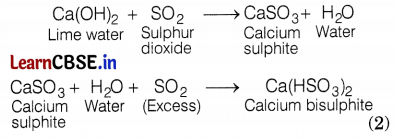
![]()
Question 28.
When ethanol reacts with ethanoic acid in the presence of conc. H
2
SO
4
, a substance with a fruity smell is produced.
Answer the following:
(a) State the class of compounds to which the fruity-smelling compounds belong. Write the chemical equation for the reaction and write the chemical name of the product formed.
(b) State the role of conc. H
2
SO
4
.
Answer:
(a) Esters.
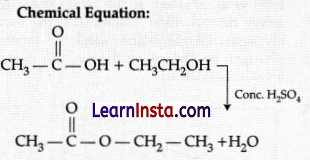
Product’s chemical name – Ethyl ethanoate
(b) Conc. H
2
SO
4
acts as a dehydrating agent. (Helps in the removal of water formed in the reaction.)
C
4
H
8
, it is an unsaturated hydrocarbon due to the presence of a double bond.
Two carbon compounds X and Y have the molecular formula C
4
H
8
, and C
5
H
12
, respectively. Which one of these is most likely to show an additional reaction? Justify your answer. iso, give the chemical equation to explain the process of addition reaction in this case.
Answer:
C
4
H
8
, it is an unsaturated hydrocarbon due to the presence of a double bond.
![]()
Question 29.
How is the sex of a child determined in human beings?
Answer:
A male germ cell that forms gametes carries one X and one Y chromosome, while a female germ cell carries two X chromosomes. Therefore, the sex of the child depends upon what happens during fertilization. (1)
(a) If a sperm carrying an X-chromosome fertilizes the egg, the child born will be a female (XX). (1/2)
(b) If a sperm carrying a Y-chromosome fertilizes the egg, the child born will be a male (XY). (1/2)
Thus, the sperm (the male gamete) determines the sex of the child. (1)
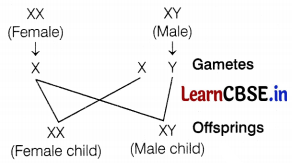
Question 30.
State briefly the changes that take place in a fertilised egg till the birth of the child in the human female reproductive system. What happens to the egg when it is not fertilised?
Answer:
Changes in the fertilised egg:
(i) Zygote/fertilised egg start dividing.
(ii) Implantation of the zygote in the inner uterine wall.
(iii) Embryo starts growing with the help of the placenta which results in the development of the child.
(iv) Birth of a child as a result of rhythmic contraction of the muscles in the uterus.
When an egg is not fertilized, the inner lining of the uterus slowly breaks and comes out through the vagina as blood and mucous (Menstruation).
Question 31.
A 6 cm tall object is placed perpendicular to the principal axis of a convex lens of focal length 25 cm. The distance of the object from the lens is 40 cm. Then, determine (a) the position (b) and the size of the image formed.
Answer:
Given, the height of the object, h
0
= 6 cm
The focal length of the lens, f = 25 cm
Distance of the object, u = -40 cm
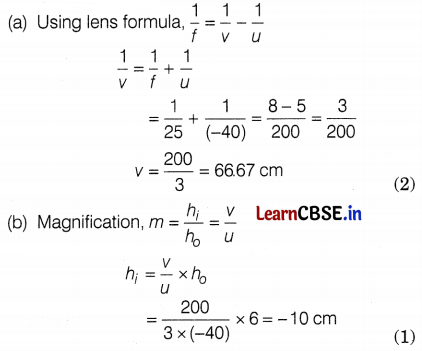
![]()
Question 32.
(a) What is the heating effect of electric current?
(b) Write an expression for the amount of heat produced in a resistor when an electric current is passed through it stating the meanings of the symbols used.
(c) Name two appliances based on the heating effect of electric current,
Answer:
(a) When electricity is supplied to a purely resistive conductor, the energy of electric current gets dissipated entirely in the form of heat. As a result, the resistor gets heated. The heating of a resistor because of the dissipation of electrical energy is known as the heating effect of electric current.
(b) When an electric current I passes through the conductor, the amount of heat produced in time t is:
H = Vlt
Since, V = IR
So, H = l
2
Rt
(c) Two appliances based on the heating effect of electric current are electric iron and electric geyser.
Question 33.
Some modern insecticides have been introduced each having different properties like accumulation in the bodies of predators, broken down by soil bacteria, easily washed into lakes and rivers, and taken up by plant roots. Among all these insecticides, which one will help in reducing or keeping the level of environmental pollution to the lowest?
Answer:
Insecticides are non-biodegradable chemicals added to crop fields to stop the growth of insects infecting the crops. Modern insecticides are being developed keeping in mind, the harm they cause to the environment and its components. (1)
False
biomagnification: insecticides accumulate along the food chain resulting in significant amounts in the tissues of consumers at the highest trophic level . new insecticides can easily get decomposed into simpler components by soil bacteria, will help in reducing or keeping the level of environmental pollution to the lowest .
Section D
Questions No. 34 to 36 are long answer questions.
Question 34.
Write the chemical equation for the following:
(a) Combustion of methane
(b) Oxidation of ethanol
(c) Hydrogenation of ethene
(d) Esterification reaction
(e) Saponification reaction
Answer:
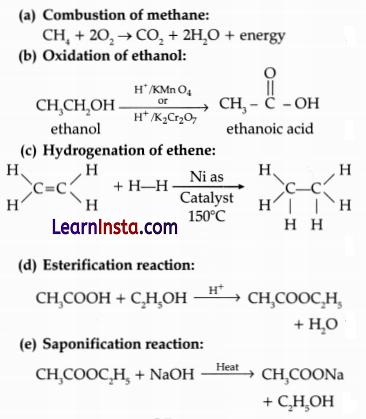
(a) Draw two structural isomers of butane.
(b) Draw the structures of propanol and propanone
(c) Name the third homologue of (a) alcohols (b) aldehydes
(d) Name the following:
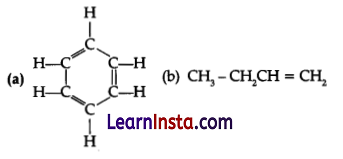
(e) Show the covalent bond formation in nitrogen molecules.
Answer:
(a) Structural formulae of isomers of Butane are n-butane and isobutane.
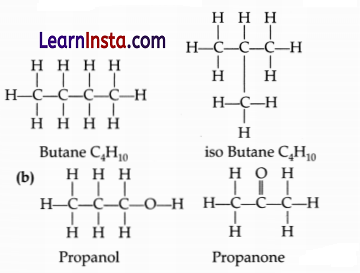
(c) (i) 3
rd
homologue of alcohol is propanol (C
3
H
7
OH).
(ii) 3
rd
homologue of aldehyde is propanal (CH
3
CH
2
CHO)
(d) (i) Benzene (C
6
H
6
)
(ii) 1- Butene
(e) Covalent bond formation in Nitrogen molecule:

Question 35.
(a) Write differences between pollination and fertilization
(b) ‘Reproduction helps in providing stability to the population of a species’. Justify this statement.
Or
(a) Name the plant, different characteristics, and contrasting pairs, Mendel used for his experiments. What type of progeny was obtained by Mendel in F
1
and F
2
generations when he crossed the tall and short plants? Write the ratio he obtained in F
2
-generation plants.
(b) How do Mendel’s experiments show that traits may be dominant or recessive? Also, explain how gametes maintain their purity during reproduction.
Answer:
(a) Differences between pollination and fertilization are as follows: (\(\frac{1}{2}\) × 6)
| Pollination | Fertilisation |
| (i) It is the transfer of pollen grains from anther to the stigma of the same or different flower. | (i) It is the fusion of a male and a female gamete. |
| (ii) It carries male gamete-producing pollen grain to the female sex organs. | (ii) It leads to the formation of a zygote. |
| (iii) It is a physical process. | (iii) It is a biological process. |
| (iv) It occurs in seed plants only. | (iv) It occurs in both plants and animals. |
| (v) It is an external process. | (v) It can either be internal or external. |
| (vi) It leads to the formation of seeds. | (vi) This process leads to fertilization. |
(b) Reproduction is the process of producing new individuals of the same species by existing organisms of a species. It ensures the transfer of genetic materials from the first generation to the next generation. (1)
It is important for the continuity of the generation of an organism or species as DNA copying during reproduction helps to produce similar individuals as their parents to maintain the stability of a species. (1)
Or
(a) Mendel used the pea plant for his experiments. Seven pairs of contrasting characters in pea plants were studied by Mendel. (1)
| Character | Dominant trait | Recessive trait |
| Seed shape | Round | Wrinkled |
| Seed colour | Yellow | Green |
| Flower colour | Violet | White |
| Pod shape | Full | Constricted |
| Pod colour | Green | Yellow |
| Flower position | Axial | Terminal |
| Stem height | Tall | Dwarf |
The progeny produced from them, F1-generation plants were all tall. (1)
Then Mendel allowed F1 progeny plants to undergo self-pollination. In the F
2
generation, he found that all plants were not tall, three quarters were tall and one-quarter of them were short. The ratio he obtained in F
2
-generation plants is 3 : 1. (1)
(b) When plants with two contrasting characters (e.g. tall and dwarf) are crossed, only one character is visible in F
1
-generation and the other character is suppressed. It shows the dominance of one character over another. The F
1
hybrid when selfed, produced plants with both dominant and recessive phenotypes. (1)
It showed that the two unit factors of a character that remain together in an individual do not get mixed up, or get contaminated and keep their distinct identity. They separate or segregate during gamete formation. (1)
![]()
Question 36.
Analyse the following observation table showing the variation of image distance (v) with object distance (u) in the case of a convex lens and answer the questions that follow without doing any calculations:
| S. No | Object-Distance u(cm) | Image-Distance v(cm) |
| 1 | -100 | +25 |
| 2 | -60 | +30 |
| 3 | -40 | +40 |
| 4 | -30 | +60 |
| 5 | -25 | +100 |
| 6 | -15 | +120 |
(a) What is the focal length of the convex lens? Give a reason to justify your answer.
(b) Write the serial number of the observation, which is not correct. On what basis have you arrived at this conclusion?
(c) Select an appropriate scale and draw a ray diagram for the observation at S.No. 2. Also find the approximate value of magnification.
Answer:
(a) The focal length of the convex lens can be calculated from S.No. 3 as when an object is placed at a distance from the convex lens, its image is formed on the other side of the lens at the same distance from the lens. So, the focal length is + 20 cm.
(b) S.No. 6 is incorrect as the object distance is between the focus and pole and here the real image is formed as the image distance is positive. But in such situation, virtual image should form.
(c) Approximate value of magnification for object distance – 60 cm and image distance +30 cm is -0.5.
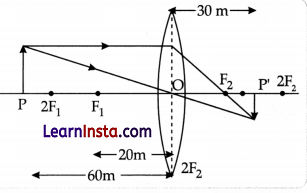
u = -60 cm; v = + 30 cm,/ = – 20 cm m = v/u = 30/-60= 1/2 = -0.5
(a) A security mirror used in a big showroom has a radius of curvature 5 m. If the customer is standing at a distance of 20 m from the cash counter, find the position, nature and size of the image formed in the security mirror.
(b) Neha visited a dentist in his clinic. She observed that the dentist was holding an instrument fitted with a mirror. State the nature of this mirror and the reason for its use in the instrument used by dentist.
Answer:
(a) It is a convex mirror. So focal length should be positive.
Radius of curvature R = + 5 m
∴ Focal length f = 5/2 + 2.5 m
Object distance u =- 20 m
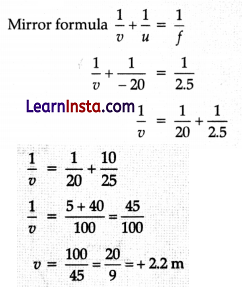
- Nature of image = virtual and erect image1
- Size of image: diminished image
(a) Concave Mirror – Reason: to obtain an erect and enlarged image of teeth. (b) Concave Mirror – Reason: to obtain an erect and enlarged image of teeth. (c) Concave Mirror – Reason: to obtain an erect and enlarged image of teeth.
Section E
Questions No. 37 to 39 are case-based/data-based questions with 2 to 3 short sub-parts. Internal choice is provided in one of these sub-parts.
Question 37.
The table given below shows the hints given by the quiz master in a quiz.
| Hints |
| (i) Substance ‘A’ is used as a refrigerant and food additive. |
| (ii) ‘A’ on reduction gives ‘B’. |
| (iii) ‘B’ is mainly used to produce ethylene. |
| (iv) ‘B’ on reaction with chlorine in the presence of sunlight gives ‘C’. |
| (v) ‘C’ is a colorless gas with a pungent odour. |
Based on the above hints answer the following questions.
(a) Name the compounds A and C.
(b) Write the chemical equation for the conversion of A to B and B to C.
Or
What is the industrial name of ‘A’? Give its industrial uses.
Answer:
(a) A – Ethene, C – Chloroethane (2)
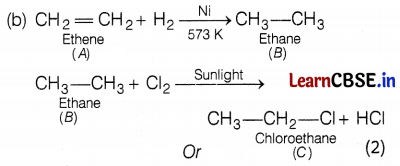
The industrial name of ethyne is acetylene.
Uses of ethyne are
(i) It is used in the manufacture of polythene.
(ii) It is used as an illuminant. (2)
Question 38.
Mendel blended his knowledge of science and mathematics to keep the count of the individuals exhibiting a particular trait in each generation. He observed several contrasting visible characters controlled in pea plants in the field. He conducted many experiments to arrive at the laws of inheritance.
(a) What do the F
1
progeny of tall plants with round seeds and short plants with wrinkled seeds look like?
(b) Name the recessive traits in the above case.
(c) Mention the type of the new combinations of plants obtained in F
2
progeny along with their ratio, if F
1
progeny was allowed to self-pollinate.
Answer:
(a) F
1
progeny of tall plants with round seeds and short plants with wrinkled seeds will be a heterozygous tall plant with round seeds (TtRr) as tall and round is the dominant traits.
(b) The recessive traits are short plants and wrinkled seeds.
(c) The different types of combinations obtained in F
2
progeny are:
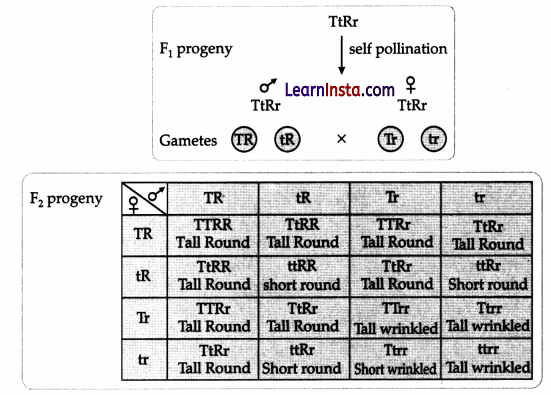
Tall plants with round seeds = 9 Short plants with round seeds = 3 Tall plants with wrinkled seeds = 3 Short plants with wrinkled seeds = 1 Phenotypic ratio = Tall round: short round: tall wrinkled: short wrinkled: 9:3:3:1.
(c) If 1600 plants were obtained in F
2
progeny, write the number of plants having traits:
(i) Tall with round seeds.
(ii) Short with wrinkled seeds.
Write the conclusion of the above experiment.
Answer:
If 1600 plants were obtained in F2 progeny, the number of plants having traits will be:
(i) Tall plants with round seeds = 9/16 × 1600 = 900
(ii) Short plants with wrinkled seeds = 1/16 × 1600 = 100
The conclusion of the above experiment states the “Law of independent assortment”. This law states that the alleles of two (or more) different genes get sorted into gametes independently of one another.
![]()
Question 39.
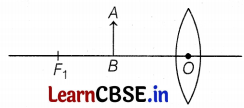
In an experiment, the formation of an image for an object AB placed in front of a convex lens is shown above in the figure, with an incomplete ray diagram.
(a) Based on text data given in the above paragraph, if the object is placed at infinity, then where is the position of the image formed by the lens?
(b) What is the nature and size of the image formed by the convex lens?
(c) For the given position of an object in the figure, where will be the image formed?
Or
If the focal length of the lens is 8 cm and an object is placed at 12 cm from the optical center, then find the position of the image formed.
Answer:
(a) The convex lens has the property to converge the parallel beam of light rays at 4 points, i.e., the focus of the lens. Hence, the image will be formed at the focus. (1)
(b) In this case, the nature of the image formed by a convex lens is virtual and erect. The size of the image is larger than that of the object, i.e. magnified image will be formed. (1)
(c) The formation of the image is as shown below:
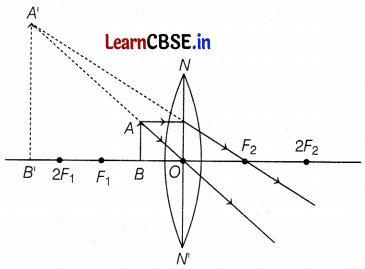
Hence, the position of the image is beyond 2F1 on the same side of the object. (2)
Or
Given, the focal length of the lens, f = 8 cm
Object distance, u = -12 cm
Using lens formula, \(\frac{1}{f}=\frac{1}{v}-\frac{1}{u}\)
⇒ \(\frac{1}{8}=\frac{1}{v}-\frac{1}{-12}\)
⇒ \(\frac{1}{v}=\frac{1}{24}\)
⇒ v = 24 cm
Hence, the image will be formed at a distance of 24 cm from the optical centre. (2)